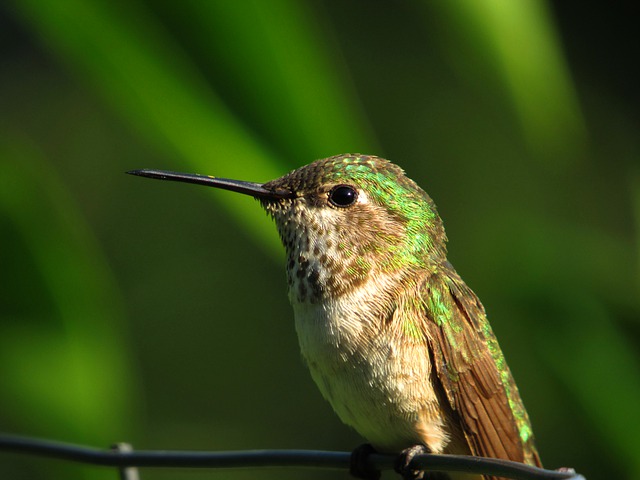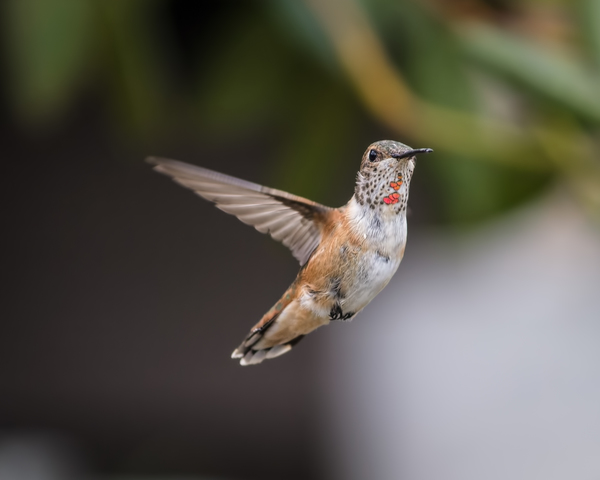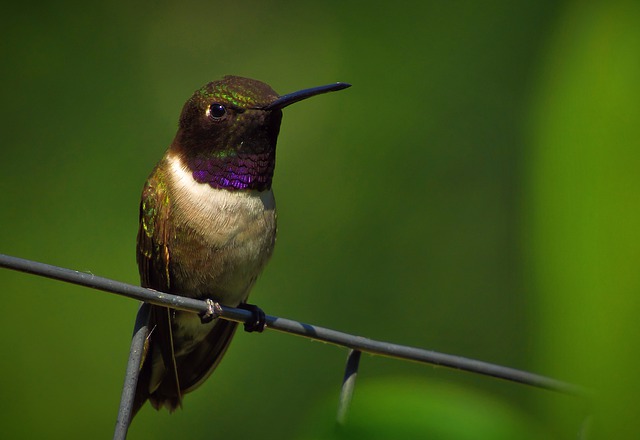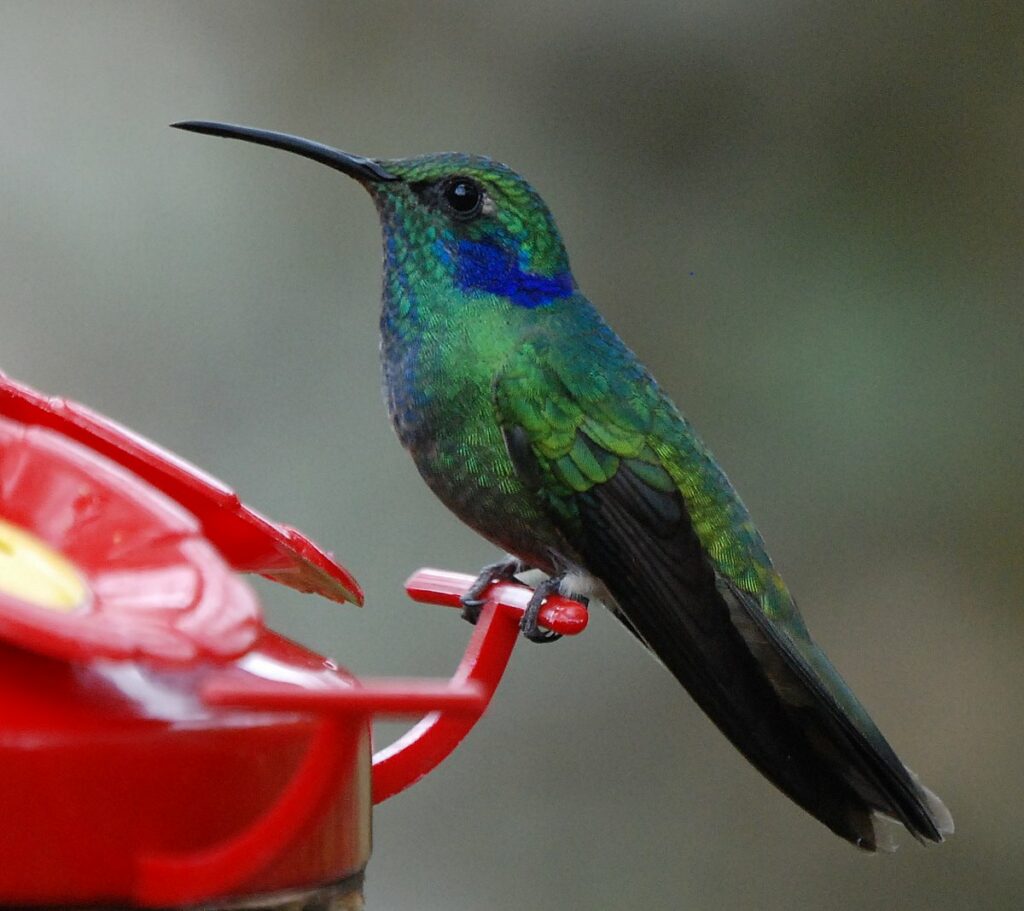Hummingbirds are some of the most fascinating and beautiful birds found in Ontario.
These tiny birds are known for their incredible agility, hovering capabilities, and vibrant colors.
There are seven different species of hummingbirds found in Ontario, each with its own unique characteristics and habits.
This article will explore the seven different types of hummingbirds found in Ontario and provide information about their physical appearance, behavior, and habitat.
Whether you are a bird enthusiast or simply enjoy learning about nature, this article is a must-read for anyone interested in hummingbirds and the diverse bird life found in Ontario.
| Image | Name |
|---|---|
 | Ruby-Throated Hummingbird |
 | Rufous Hummingbird |
 | Calliope Hummingbird |
 | Anna’s Hummingbird |
 | Broad-billed Hummingbird |
 | Black-chinned Hummingbird |
 | Mexican Violetear |
Types of Hummingbirds in Ontario
1. Ruby-Throated Hummingbird

The Ruby-Throated Hummingbird is the most common species of hummingbird found in Ontario, Canada.
This species is considered to be a “special concern” in the province due to its limited range and decreasing population.
The Ruby-Throated Hummingbird is a small species of bird with an average length of 8-10 cm and a mass of 3-5 grams.
This species can be identified by its vibrant iridescent green feathers, slender bill, and white throat with a ruby red streak.
The Ruby-Throated Hummingbird is a migratory species, spending its summers breeding in Ontario and its winters in southern Mexico, Central America, and the Caribbean.
During the summer months, the Ruby-Throated Hummingbird can be found in deciduous and coniferous forests, meadows, and open areas with abundant nectar sources.
This species primarily feeds on nectar from flowers but also occasionally feeds on small insects and spiders.
The Ruby-Throated Hummingbird is a solitary species and is typically found alone or in pairs during the breeding season.
The male Ruby-Throated Hummingbird will perform an elaborate courtship display involving hovering and dive-bombing in front of the female to attract a mate.
The female will typically build a cup-shaped nest out of lichens, moss, and spider webs in sheltered areas, such as shrubs or trees.
The female Ruby-Throated Hummingbird will lay up to two eggs, which she will incubate for approximately two weeks.
The young will fledge, or leave the nest, approximately three weeks after hatching.
2. Rufous Hummingbird

Rufous Hummingbird is an endangered species in Ontario.
It may still be seen there from July through January when the weather is milder.
The southern part of the province, namely near Montreal, Lake Superior, and Toronto, is where you’ll most likely see one of these birds.
In addition to their brilliant red throats, male Rufous Hummingbirds have vivid orange feathers on their bellies and backs.
Females have a creamy underbelly and rusty sides and back.
Among the most migratory birds compared to its size, the Rufous Hummingbird may fly up to 4,000 miles on one trip.
They spend the summer breeding in far northwestern Canada and Alaska and the winters in the southern United States, namely Mexico and the southern Gulf Coast.
Rufous Hummingbirds migrate along the Pacific Coast to the north in the springtime and the Rocky Mountains to the north in the autumn.
Beginning in February, spring migration of Rufous Hummingbirds often reaches Alaska by mid-April.
Autumn migration begins in July and August and lasts through October.
The research found that rufous hummingbirds are leaving their southern breeding grounds sooner and venturing further inland as they make their way north.
In addition to insects like flies, gnats, and midges, the primary food source for Rufous Hummingbirds is the nectar of brightly colored tubular flowers.
They construct a nest in a tree tier, utilizing plant down and spider webs for support.
It is two to three little white eggs that are around 0.55 inches (1.4 centimeters) in length.
Mountainous areas with open meadows and dense woods are their natural environment.
During migration, they become very aggressive and drive away any other hummingbirds which might approach, including bigger hummingbirds and permanent residents.
Although they don’t stick around for long, they will drive away other hummingbirds if they have a chance throughout the migration.
3. Calliope Hummingbird

There have only been two confirmed sightings of Calliope Hummingbirds across Ontario, both in Goderich in 2018.
Little larger than a ping-pong ball, the Calliope Hummingbird seems to be the tiniest bird in the United States.
Despite its diminutive size, it travels more than 5,000 miles annually, from Canada to Mexico and back.
When it comes to protecting their area, they are formidable foes, even chasing down Red-tailed Hawks.
Calliope hummingbirds possess shiny greenish sides and backs, black tails, and a brilliant magenta neck (called a gorget).
Unlike males, females do not have iridescent necks, and their underbelly is pinkish-white instead of pure white.
The Rocky Mountains, all along Pacific Coast, are the destination for the annual spring migration of Calliope Hummingbirds, which fly south to breed in Colorado and southern California and north to Vancouver Island, British Columbia, Alberta, and the northern United States.
Migratory birds begin leaving their southern breeding grounds in early February, arriving in Canada as late as May.
The Rocky Mountains serve as a landmark for the late-August and early-September migration of birds to their wintering sites in southern Mexico and, more lately, the Gulf Coast.
Nests are often located in coniferous forests, and the birds have been known to either rebuild atop or reuse an existing one.
4. Anna’s Hummingbird

Although thought to have been extinct across Ontario, Anna’s Hummingbirds have been observed in Carleton Place as recently as 2017.
These are little birds that are mostly greenish and gray, and they are called Anna’s Hummingbirds.
The man has a brilliant reddish-pink sheen on his neck and head.
The female has a whitish neck and a reddish spotty throat.
Unlike other hummingbirds, Anna’s Hummingbirds don’t really migrate, making them the most frequent hummingbird near the Pacific Coast.
Both in the summertime and the winter, you may find them in areas as far south as Baja California in British Columbia.
Nonetheless, several avian species may spend the winter months well south of their typical range.
Anna’s hummingbirds prefer suburban gardens and urban parks with many flowering plants and nectar feeders, although they also frequent savannah and scrub.
Anna’s Hummingbirds get their nutrition from a variety of sources, including tree sap, nectar, spiders, and insects of a suitable size.
Arctostaphylos, Nicotiana plants, Eucalyptus trees, Agaves, Diplaucus, Castillejas, Ribes, Silena, and nectar-feeding insects all produce nectar.
Males perform spectacular dive displays during courting by soaring to an altitude of 132 feet, where their tail plumage generate a rustling noise as they swoop down to earth.
5. Broad-billed Hummingbird

Hummingbirds are classified as an incidental species across Ontario.
They are exceedingly uncommon throughout the province, with the latest sighting being in 1989.
Broad-billed Hummingbirds are brightly colored.
Males possess a brilliant metallic greenish across the body with a blue neck that continues down the chest.
Females possess a light abdomen, and both males and females possess red beaks that seem to be black-tipped and broad towards their forehead.
Hummingbirds reside throughout the Pacific Coast of Mexico and central Mexico most of the year.
Some birds move north into mountain valleys across New Mexico and southern Arizona for mating between March and October, while a few stay throughout the year near the Mexican borderline.
Broad-billed Hummingbirds forage among canyon streams and alpine grasslands, but they will sometimes visit garden feeders.
Nests are constructed relatively low to the ground, roughly 3 to 5 feet above, near streams.
6. Black-chinned Hummingbird

Black-chinned Hummingbirds remain exceedingly uncommon and are classified as an incidental species throughout Ontario.
In accordance with the Ontario Bird Records Database, they were last sighted in the territory in 1990.
Black-chinned Hummingbirds have a dull glossy greenish back and a brownish-gray underside.
Males possess a black neck with a short shimmering violet base, while females possess a light neck and white ends on their tail plumage.
Black-chinned Hummingbirds breed mostly inland across western states across British Columbia through Baja California in the summertime.
After reproducing, they may go to higher mountain regions with numerous blooms before wintering in the Gulf Coast, western Mexico, and southern California.
The Black-chinned Hummingbird migrates between March and September.
They consume spiders, nectar, and tiny insects, and their tongues may lick 14 to 18 times per second while eating on nectar.
Black-chinned Hummingbird nests are formed of plant down and spider silk to keep them together, and they deposit two small whitish eggs that are barely 0.7 inches long (1.6 centimeters)
Black-chinned Hummingbirds are frequently spotted perched at the tops of tree stumps on small bare twigs, and they frequently revisit a preferred perch.
These may be seen along canyons, waterways, and shaded oaks.
7. Mexican Violetear

Mexican Violetear (Colibri Thalassinus) is a species of hummingbird that has recently been found in Ontario, Canada.
This species is native to Mexico and Central America but has been expanding its range northward.
The Mexican Violetear is a large hummingbird with a bright purple-violet crown and a white throat with a contrasting black band.
This species was first documented in Ontario in 2006 and has become increasingly more common in the province over the last decade.
The Mexican Violetear is especially fond of open fields and meadows, where they can feed on their favorite food sources, such as insects and small flowers.
They will also visit bird feeders and gardens where they can find nectar and insects.
They are known to be quite vocal, often calling out in a loud, high-pitched ‘tseep.’
This species is fairly adaptable to human-altered habitats and can often be found near urban and suburban areas.
The Mexican Violetear is a territorial bird and will defend its feeding areas from other hummingbirds.
They will also occasionally migrate north in the summer months, but they are not known to travel outside of Canada.
Conclusion
In conclusion, the province of Ontario is home to a diverse and fascinating array of hummingbirds.
From the enchanting Ruby-throated Hummingbird to the rare Rufous Hummingbird, these tiny avian jewels captivate our imaginations and hearts.
Each species showcases unique adaptations and behaviors, which are vital for their survival in the diverse landscapes of Ontario.
The presence of these seven hummingbird species offers residents and visitors alike an unparalleled opportunity to observe and appreciate these delightful creatures in their natural habitats.
Ultimately, it is our collective responsibility to protect and conserve their ecosystems, ensuring that future generations can continue to marvel at the mesmerizing beauty and wonder of Ontario’s hummingbirds.
FAQ
When is the best time to spot hummingbirds in Ontario?
The prime time to spot hummingbirds in Ontario is from late April to early October, with peak activity during the summer months of June, July, and August. Migration patterns may affect the exact timing.
How can I attract hummingbirds to my garden?
Planting native flowers, especially those with tubular shapes and vibrant colors (such as red, orange, and pink), can help attract hummingbirds. Additionally, hanging nectar feeders and providing a clean water source will increase your chances of drawing these beautiful birds to your garden.
What do hummingbirds eat?
Hummingbirds primarily feed on nectar from flowers, which provides them with the energy they need for their high metabolism. They also consume insects and spiders for protein, especially during the breeding season.
Are there any conservation efforts in place for hummingbirds in Ontario?
Several organizations, such as Bird Studies Canada and local naturalist clubs, work to monitor and conserve hummingbird populations in Ontario. You can contribute to conservation efforts by creating hummingbird-friendly habitats in your yard and participating in citizen science initiatives like the Ontario Hummingbird Project.
How can I identify the different types of hummingbirds in Ontario?
Identifying hummingbird species can be challenging due to their small size and rapid movements. Look for distinguishing features such as throat color, size, and markings on their wings and tails. Consult field guides, online resources, and local experts for assistance in identification.
How do hummingbirds survive the winter in Ontario?
Most hummingbirds are migratory and leave Ontario during the winter months, traveling to warmer climates in the southern United States, Central America, or South America. However, some species like Anna’s Hummingbird are known to overwinter in milder coastal areas, relying on their ability to enter torpor—a state of reduced metabolism—to survive colder temperatures.
Last Updated on March 22, 2023 by Lily Aldrin
